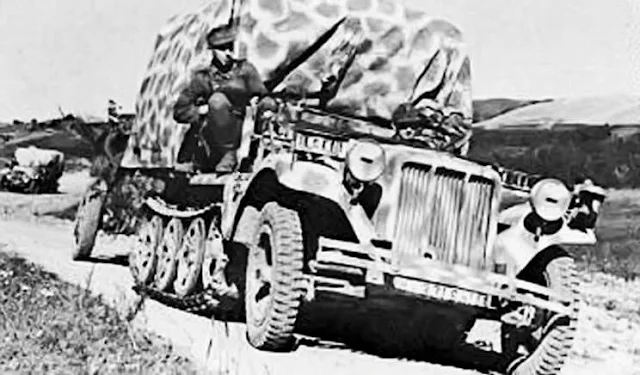 |
| SdKfz 251 half-track. |
.jpg) |
| SdKfz 251 half-track. |
 |
| SdKfz 251 half-track, right. |
 |
| SdKfz 252 munitions carrier. |
 |
| Sd.Kfz. 251 engineer half-tracks and crews being transported by train. |
 |
| A raid into enemy territory bagged a British 25-pdr field gun near the Halfaya Pass, Libya, May 1941. |
 |
| 20mm dual-purpose gun on SdKfz 10 half-track. |
 |
| The 2 cm Flak 38 anti-aircraft gun was introduced in 1940 to replace the 2 cm Flak 30. Except for the higher rate of fire (450 rpm versus 280 rpm), nothing else changed in the performance of the gun. |
 |
| Towing the 5 cm Pak 38 L/40 was another task for the much utilized 1-ton prime mover. |
 |
| Flak 20mm training, France. |
 |
| Wrecked German half-track. |
 |
| Wrecked German half-track. |
 |
| A Panzer IV Ausf. J of the 12th SS Panzer Division (“Hitlerjugend”) on a Normandy road. |
 |
| JgdPz 38(t) Hetzer in a very carefully applied Hinterhalt-Tarnung. Notice how you can more or less differentiate the different colors by shade. |
 |
| Repairing a Panzer III (possibly of the 11th Panzer Division) using a Zugkraftwagen 18 t mit Kran (Sd.Kfz. 9/1), Soviet Union, January 1943. |
 |
| Panzer III on a Sd.Ah 116 transport trailer being towed by a Sd.Kfz.9 Famo. |
 |
| A knocked-out PzKpfw III tank, with the body of one of its crew lying on the hull, 24 February 1943. |
 |
| PzKpfw IIIs and SdKfz 250 half-tracks, Russia. |
 |
| Captured PzKpfw III Ausf G, North Africa. |
 |
| PzKpfw III, North Africa. |
 |
| PzKpfw III, North Africa. |
 |
| PzKpfw III, North Africa. |
 |
| PzKpfw III Ausf E. |
 |
| German soldiers pull a staff car through the heavy mud of the Russian roads, November 1941. |
 |
| German soldiers crossing a Russian River on their self-propelled gun on 3 August 1942. |
 |
| Looking inside a gepanzerte Selbstfahrlafette für Sturmgeschütz 7.5 cm Kanone (SdKfz 142) Ausf B. |
 |
| Sturmpanzer I Bison self-propelled gun built on the Panzer I chassis. |
 |
| Tiger I tank in the north of France. |
 |
| Henschel Panzerkampfwagen VI Tiger II in Budapest in 1945. |
 |
| German Army parade in Berlin in 1939 for Hitler’s 50th birthday. Panzer II light tanks on Faun L900 transporters. |
 |
| French Panhard 178 armored car with a 5.0cm KwK L/60 gun in German service. |
 |
| In a carefully posed photo a Lithuanian farm girl welcomes panzer troops in front of their Panhard 178 armored car. |
 |
| 15-cm Panzerwerfer 42. Note the canvas cover over the rocket projector barrels. |
 |
| 15-cm Panzerwerfer 42 (SdKfz 4/1) auf Maultier (Opel) heavily camouflaged with branches. |
 |
| Panzerwerfer 42 in action. |
 |
| 15cm Panzerwerfer 42 on a Schwerer Wehrmachtschlepper (SWS). |
 |
| Three abandoned 30cm Raketenwerfer 56s in front of munitionspanzers, Oelle, April 1945. |
 |
| French Canon Automoteur Somua Sau 40 in German service. |
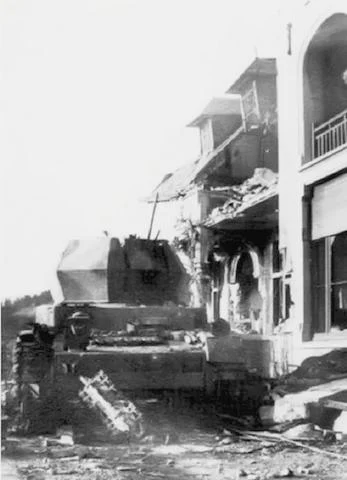 |
| The battle over, a Wirbelwind stands abandoned outside the hotly-contested ‘Festung Sankt-Edouard’ in Stoumont during the Battle of the Bulge. |
 |
| Kfz 13, 1934. |
 |
| Kfz 13. |
 |
| German soldiers in what appears to be a civilian car (note the license plate and “WH” on the fender) impressed into military service. |
 |
| Kfz 15 (Mercedes-Benz 340) used by medical personnel of the Afrika Korps, Tobruk, June 1942. |
 |
| German motorcycle with sidecar combination in Russian winter. |
 |
| Waffen-SS troops struggle with a motorcycle bogged down in mud, Karelia, Russia. |
 |
| Horse-drawn transport of the German army in the melting snow. |
 |
| German soldiers move their field kitchen by hand. |
 |
| The passengers of a Wehrmacht staff car help move it through a watery section of a muddy road in Russia. |
 |
| Kfz 69 with 2cm Flak 30 mounted on floor, in front of German landing craft. |
 |
| Horch ambulance, 3rd Panzer Division, Don/Stalingrad campaign, 1942. |
 |
| Büssing-NAG ambulance. |
 |
| Ford Kfz 31 ambulance. |
 |
| MAN Type E2 bus ambulance. |
 |
| Opel 1.5 ton ambulance. |
 |
| Phänomen Kfz 31 truck. |
 |
| Truck speeds through a muddy puddle on a road in Russia. |
 |
| Ambulance in North Africa. One crew member pours water from a wash basin onto a lone plant in the desert. Note the Afrika Korps symbol and Edelweiss on the rear of the truck's van. |
 |
| German troops mounted in trucks during a pre-war review. |
 |
| German trucks carry troops during pre-war maneuvers. Note the Reichswehr (RW) license plates. |
 |
| Radio communications van in operation. |
 |
| As the crew of a broken down truck try to fix the problem, another soldier warns following vehicles. The farthest vehicle visible is an Opel Blitz Mod. 3.6-36S (4x2). |
 |
| Camouflaged truck of a Waffen-SS unit pauses in a field during a battle. |
 |
| Close up of the cab of a truck with most of the front windows painted over to eliminate the glare of reflection. |
 |
| Truck begins its trip across a river on a ferry. |
 |
| Ambulance moves across a small stream over a log bridge. |
 |
| Truck column pauses by the side of a road during a motor march. |
 |
| SdKfz 10 leichter Zugkraftwagen 1t half-tracks in use as tractors for the 5cm PaK 38 anti-tank gun. |
 |
| Nebelwerfer (rocket projector) units also utilized the 1-ton Demag to tow the mobile 28/32 cm Nebelwerfer 41 which weighed approximately 2,500 pounds. |
 |
| The Kettenlaufwerk (tracks) consists of the front driving sprocket, the idler wheel at the rear and five pairs of pressed steel, rubber-tired bogie wheels. |
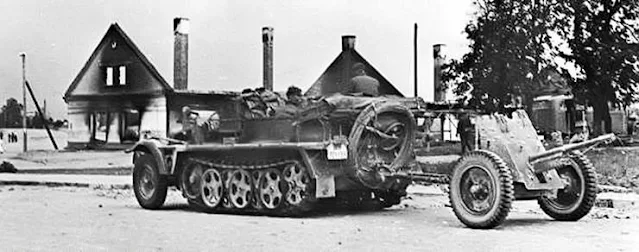 |
| Leichter Zugkraftwagen 1t Typ D7 (SdKfz 10) pulling a 3.7-cm Pak 35 on the Eastern Front. |
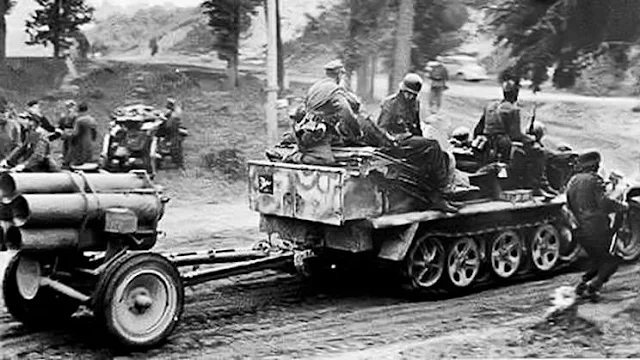 |
| An SdKfz 10 towing a 21-cm Nebelwerfer 42. |
 |
| 2-cm Flak 38 (Sf.) auf le.Zgkw. 1t (SdKfz 10/4). |
 |
| 2-cm Flak 38 (Sf.) auf le.Zgkw. 1t (SdKfz 10/4) in Greece. Note the open ammo box with one 20 round magazine partly visible. |
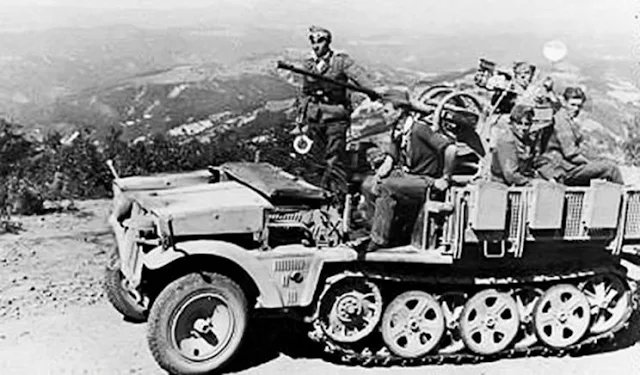 |
| SdKfz 10/4. |
 |
| SdKfz 10/4 in action. Note the stacks of ammo magazines. |
 |
| SdKfz 10/4: Partly armored version on the Eastern Front. The trailer behind the gun carried additional ammo and the personal belongings of the crew. |
 |
| SdKfz 10/4: Partly armored vehicle on the Eastern Front. Ammo boxes holding two magazines each are fitted on the outside of the vehicle. |
 |
| Panzergrenadiers leap from their SdKfz 250 half-track during action on the Russian Front. |
 |
| Dismounted panzergrenadiers man an MG 34 position as an SdKfz 251 passes by, while burning oil tanks darken the sky. Eastern Front. |
 |
| The SdKfz 251 has moved forward as an SdKfz 250 moves up from behind. |
 |
| SdKfz 251 half-track. |
 |
| SdKfz 251 half-track. |
 |
| SdKfz 251/3 mittlerer Kommandopanzerwagen (Funkpanzerwagen). Communications vehicle, fitted with extra radio equipment for command use in Ausf. C and Ausf. D versions. 12th SS Panzer Division, 1944. |
 |
| SdKfz 251/1 II: Rocket launcher (called "Stuka zu Fuß" (Walking Stuka) or Wurfrahmen 40) equipped with six side mounted frames for launching 280 mm or 320 mm Wurfkoerper rockets. In action in Russia. |
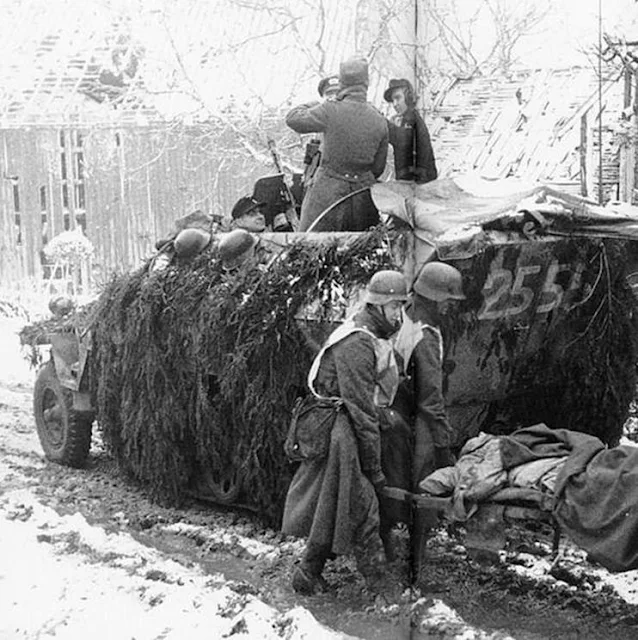 |
| SdKfz 251 half-track. |
 |
| The ammunition carrier was only lightly armored (15 mm front and 8 mm sides) and differed mainly from the SdKfz 250 by the sloping rear superstructure. |
 |
| The front view of the SdKfz 252 is identical with the SdKfz 250 armored troop carrier. |
 |
| A large double hatch allowed for loading and unloading of the ammunition. |
 |
| Leichter gepanzerter Munitionstransportkraftwagen (SdKfz 252). |
 |
| Before the autumn rains, a motorcycle with sidecar and a SdKfz 252 half-track ammunition carrier with ammunition trailer from a panzer unit easily fords a Russian stream. |
 |
| SdKfz 252 munitions carrier with munitions trailer. |
 |
| A convoy of surrendering SS troops near Enns, Austria. |
 |
| German infantry and PzKpfw III Ausf F during street fighting, Russia. |
 |
| PzKpfw III, North Africa. |
 |
| British soldier inspects a makeshift grave, with a destroyed German Panzer III in background. |
 |
| Russian mud, an indefatigable enemy. A Tiger I tank stuck on the bank of a river near Znamenka Kirovograd, a village in the Ukraine, April 4, 1943. |
 |
| Captured Soviet SU-122 in German service. |
 |
| Captured Soviet SU-152 in German service. |
 |
| 7.5 cm Kanone L/40 für Selbstfahrlafette (Krupp). |
 |
| 7.5 cm Kanone L/40 für Selbstfahrlafette (Krupp). |
 |
| Mockup of Sturmgeschütz 40 mit 7.5 cm Pak 42 L/70, spring of 1943. |
 |
| Mockup of Sturmgeschütz 40 mit 7.5 cm Pak 42 L/70, spring of 1943. |
 |
| Destroyed Stug III being examined by Russian officers. |
 |
| Stug III. |
 |
| Sturmmörserwagen 606/4 mit 38 cm RW 61 Sturmtiger in a field-applied Hinterhalt-Tarnung. This is a Sturmtiger that was captured in 1945. |
 |
| Loading shells into a Sturmtiger with the vehicle’s crane. |
 |
| Local children playing on a knocked out Sturmtiger. |
 |
| Sturmtiger fires one of its shells. |
 |
| The now famous Tiger I (8.8 cm) Ausf E Nr 131 from 1. Kompanie/schwere-Panzer-Abteilung 504, captured by the 48th Royal Tank Regiment in Tunisia. It was damaged on April 21, 1943 by a 6-Pounder gun. |
 |
| Tiger I on a railcar. |
 |
| Tiger I and armored car on a ferry. |
 |
| Tiger I being refueled from drums on a cargo truck. |
 |
| Tiger I in North Africa. |
 |
| Tiger I. |
 |
| Crew performing maintenance on their Tiger I. |
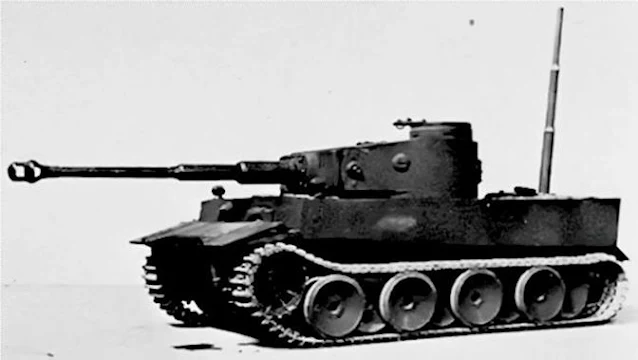 |
| Tiger I equipped for deep wading. |
 |
| Retrieving a bogged-down Tiger I. |
 |
| Refueling a Tiger I. |
 |
| Tiger I used to train Army troops to prepare them for combat against armored forces, to get used to remaining in trenches while enemy vehicles pass over their dug-in positions. |
 |
| Tiger I rolls over a German soldier in a trench. |
 |
| Tiger I rolls over a German soldier in a trench. |
 |
| Tiger I. |
 |
| Panzerkampfwagen VI Ausf. B Tiger II. |
 |
| PzKpfw VI Tiger II. |
 |
| Tiger IIs during review, 1944. |
 |
| Rear view of Tiger II at Aberdeen Proving Ground, circa early 1970s. |
 |
| Tiger II at Aberdeen Proving Ground with portions of hull and turret cutaway to exposure interior. |
























